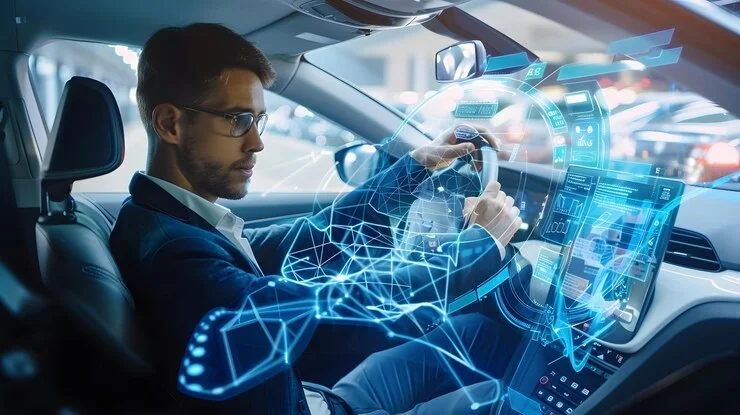Self-driving is a sci-fi sounding nod in the rearview mirror; one that is rapidly transforming into the domain of your average Joe while being refused by the established walkthrough of transportation. Autonomy is revolutionizing the development, production and movement of cars, from self-driving cars to advanced driver-assistance systems (ADAS). This article investigates how autonomous driving is changing the landscape of the automotive industry — from vehicle design and safety to regulations, consumer behavior, and the future of mobility.
The Journeys of Evolving Autonomous Driving-Automotive Industry
The development of technology that drives itself has come a long way. AVs have been in development since the 1950s, when engineers began to experiment with automation technologies. That said, it was not until all of the 21:st century that we started to see some real advancements, but these have come with the convergence of technologies such as AI, machine learning, sensors and real time data processing.
Currently, there are 5 levels of autonomous vehicles, from what would be considered a Level-0 vehicle (no automation) to a Level-5 vehicle (full automation). Level two and three — They are partial automation, which means the vehicle can perform some driving tasks, while level four vehicle is high automation and can work without any form of human intervention in specific cases. Level 5 denotes self-driving cars that do not need any human intervention.
Influence on Vehicle Development and Production-Automotive Industry
The rising wave of autonomous driving is changing the design of cars in fundamental ways with opportunities we never before could imagine. Level 4 (or Level 5) autonomous vehicles change the area to be designed from drivers to passengers — traditional vehicles were that of a driver-centric configuration. In turn, this is prompting a rethinking of vehicle interiors to make cars comfy, convenient and entertaining; more like homes on wheels.
Finally, the new sensors, cameras, and LiDAR (Light Detection and Ranging) technology which the cars/vehicles will be full of, will need to make a fundamental change of the vehicle architecture. Tech was putting a lot of money behind building out platforms to support the very complex hardware and software systems that are necessary for
Improving Security And Cut Down On Collisions-Automotive Industry
Improving road safety is one of the biggest autonomous driving promises. One of the reasons that accidents happen is because of human error, this is where autonomous vehicles come into play, as they are made to eliminate or at least decrease human errors.
Modern vehicles are already incorporating advanced driver-assistance systems (ADAS) in various segments which are improving safety, for instance adaptive cruise control, lane-keeping assist, and automatic emergency braking. Headlines are made every time one of these systems take closer steps towards fully autonomous features and the potential to avoiding crashes and saving lives becomes most apparent.
Maintaining a perfect safety record is arduous, however. Autonomous vehicles must cope with driving in inclement weather, unpredictable human behavior and challenging urban environments. This means that before full autonomy can be rolled out on a large scale, extensive testing and validation will be needed.
Legal and regulatory hurdles
One of the most consequential is the emergence of autonomous driving. Governments in different parts of the world are struggling with how to develop frameworks that make the use of autonomous vehicles safe and responsible. Some of the key issues related to regulation included (in no particular order):
Even licensing matters: Adopting basic safety standards for AVs is a vital step. They should deal with AI performance, sen sor accuracy, and the availability of driving conditions.
Liability – if an autonomous vehicle is involved in an accident, who is at fault? This leads to questions of liability: Should the manufacturer, the software developer or the vehicle owner be liable?
Data Privacy: Autonomous cars have to create a lot of data which is making data privacy and cybersecurity important issues. This data must be kept safe, secure and beyond access and abuse by criminals and the black market, and so regulations must tackle this.
The Challenges, Ethical Risks in Part Two
While the eventual benefits of self-driving cars are bright, there are some obstacles to be addressed as well as various moral dilemmas to solve. These include:
Moral issues: You cannot build a self-driving car that never has to face a situation that poses a choice where lives must be weighed against one another: the life of a pedestrian versus the life of the passenger in the self-driving car, for example. The next level challenge is ensuring that algorithms can handle these dilemmas responsibly.
Job loss: With the rise of self-driving cars comes job loss in several sectors, such as trucking, taxi transportation and delivery. It will be an interesting conundrum for policymakers and captains of industry alike as they contemplate how best to manage this transition and assist any displaced workers.
Ticking All The Right Boxes For Public AcceptancePublic acceptance is a prerequisite for widespread adoption of autonomous driving technology — which Health technology can help with Consumers have to be sure that AVs are safe and secure and are capable of reacting correctly to different driving contexts.
Conclusion The Road Ahead
Without question, autonomous driving is one the most disruptive mega-trends of all time in the automotive industry. While many of the barriers must be overcome, the benefits in safety, efficiency, and convenience are limitless.Available until October 2022 In the future of automotive, technology will have to change, whether it be aspects of vehicle design, the processes and methods to produce, regulatory developments, and consumer adoption all change.
The future of automotive transportation will be autonomous driving vehicles. However we are already well on the way there. A collaborative ecosystem with automotive manufacturers, the government, tech companies and consumers will be needed to navigate this exciting but complicated landscape. In the future, autonomous driving will
